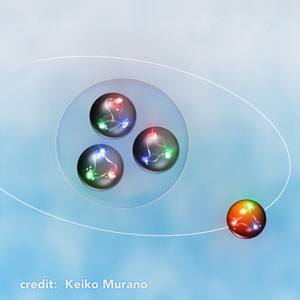Jun 29 2020
According to the predictions of calculations performed by nuclear physicists at RIKEN, when an exotic particle called a Xi hyperon is added to a helium nucleus with three nucleons, the result is a temporarily stable nucleus.
 An artist’s impression of a bound nucleus containing three normal nucleons, which have up and down quarks, and a Xi hyperon (gold sphere at bottom right), which contains two strange quarks. Calculations by RIKEN nuclear physicists predict that this exotic nucleus will be stable. Image Credit: © 2020 Keiko Murano.
An artist’s impression of a bound nucleus containing three normal nucleons, which have up and down quarks, and a Xi hyperon (gold sphere at bottom right), which contains two strange quarks. Calculations by RIKEN nuclear physicists predict that this exotic nucleus will be stable. Image Credit: © 2020 Keiko Murano.
Using this result, experimentalists can search for the nucleus and offer an understanding of nuclear physics and the structure of neutron stars.
Protons and neutrons, which are collectively called nucleons, constitute normal atomic nuclei. Each proton and neutron in turn includes three quarks. There are six types of Quarks: up, down, bottom, top, strange, and charm. However, protons and neutrons are made of only up and down quarks.
For a long time, nuclear physicists have been intrigued by hypernuclei, or nuclei that include one or more hyperons where at least one of the three quarks is a strange quark. Although nuclear physics facilities have been able to create only a handful of hypernuclei, they offer new and valuable insights into the mysteries of nuclei.
Standard nuclei are defined by how many protons and neutrons they contain, and that’s it. They’re essentially two dimensional. Hyperons offer us an extra dimension through the number of strange quarks—this enables us to gain deeper insight into a nucleus, such as the interactions that make a nucleus stable.
Takumi Doi, RIKEN Interdisciplinary Theoretical and Mathematical Sciences Program, Nishina Center for Accelerator-Based Science, RIKEN
The focus of a majority of the studies has been on hyperons that include only one strange quark. However, Xi hyperons—hyperons that have two strange quarks—are also possible. Until now, researchers have made one hypernucleus that contains a Xi hyperon and 14 nucleons.
Doi and colleagues presumed that there could be lighter hypernuclei including Xi hyperon. Hence, they carried out calculations of the interaction between a nucleon and a Xi hyperon on the K supercomputer RIKEN’s to unravel this.
The study results estimate that a hypernucleus formed of one Xi hyperon and three normal nucleons should be sufficiently stable to be created through experiments. As predicted by their calculations, this is the lightest hypernucleus to include a Xi hyperon.
The findings were very surprising as they considerably varied from those achieved using an approximation.
We predicted that the interaction is attractive when the Xi hyperon and a nucleon are in a particular state, whereas an approximate approach estimates that the corresponding potential will be repulsive. So these results are very different.
Takumi Doi, RIKEN Interdisciplinary Theoretical and Mathematical Sciences Program, Nishina Center for Accelerator-Based Science, RIKEN
Apart from offering experimentalists a goal to aim for, the study outcomes will also inform studies into neutron stars. Neutron stars are the highly dense remnants of large stars that collapse under their own gravity and experienced supernova explosions. Studies into their internal structures might offer the conditions under which hypernuclei that include Xi hyperons could occur.
Journal Reference:
Hiyama, E., et al. (2020) Possible lightest Ξ hypernucleus with modern ΞN interactions. Physical Review Letters. doi.org/10.1103/PhysRevLett.124.092501.